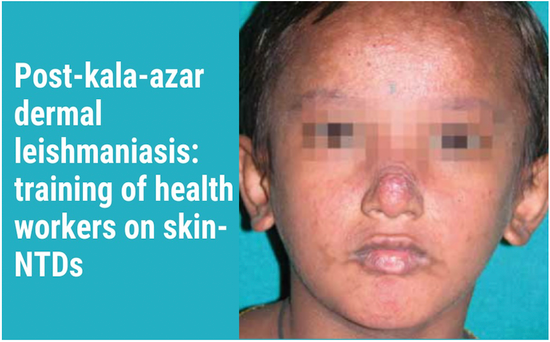
Post-kala-azar dermal leishmaniasis (PKDL) is usually a sequel of visceral leishmaniasis and is one of the skin neglected tropical diseases. It occurs mainly in East Africa and on the Indian subcontinent, where 5–10% of patients with kala-azar are reported to develop the condition. People with PKDL are considered a potential source of Leishmania infection.
Photo source: WHO manual of PKDL for health workers
语言: English
Leishmaniasis
课程信息
Post-kala-azar dermal leishmaniasis (PKDL) is considered a potential source of Leishmania infection in the community. It presents as a sequela of visceral leishmaniasis in areas endemic for L. donovani. Therefore it acts as an important link in the control and elimination of visceral leishmaniasis.
This course aims at providing health workers with the necessary knowledge to understand the epidemiology, clinical presentation, diagnosis, treatment, and surveillance of this important disease.
Learning objectives: By the end of this course, you should be able to:
- Understand the importance of PKDL, clinically and in control of visceral leishmaniasis (VL)
- Explain the epidemiology and geographical differences
- Describe the clinical aspects of PKDL
- Adequately diagnose PKDL using available tools
- Describe when and how to start treatment if needed
- Describe surveillance, monitoring, and evaluation for PKDL
Course duration: Approximately 2 hours.
Certificates: A Record of Achievement certificate will be available to participants who score at least 80% in the final assessment. Participants who receive a Record of Achievement can also download an Open Badge for this course. Click here to learn how.
课程内容
Module 1: Introduction to NTDs, skin NTDs and PKDL. Epidemiology of PKDL:
This introductory module gives an overview of Neglected Tropical Diseases, and post-kala-azar dermal leishmaniasis. Epidemiology of PDKL is also covered here. By the end of this module, you should be able to: explain main characteristics of PKDL, the risk factors triggering post-kala-azar leishmaniasis, describe the geographical distribution, and features of regional differences.Module 2: Clinical presentation and differential diagnosis:
By the end of these modules, you should be able to: describe the clinical features of PKDL in Africa, Asia and in other areas and differential diagnosis, and its presentation in HIV positive patients.Module 3: Diagnosis:
By the end of these modules, you should be able to: describe the general features to diagnose the disease and different methods of diagnosing the condition.Module 4: Treatment and monitoring of treatment in PKDL:
By the end of this module, you should be able to: describe the general overview of treatment of PKDL, various treatment regimens and monitoring the treatment including challenges in the treatment of PKDL.Module 5: Surveillance, monitoring and evaluation:
By the end of this module, you should be able to: explain NTD roadmap 2021-2030 target for PKDL, its monitoring and definitions and minimum recommended variables for reporting.